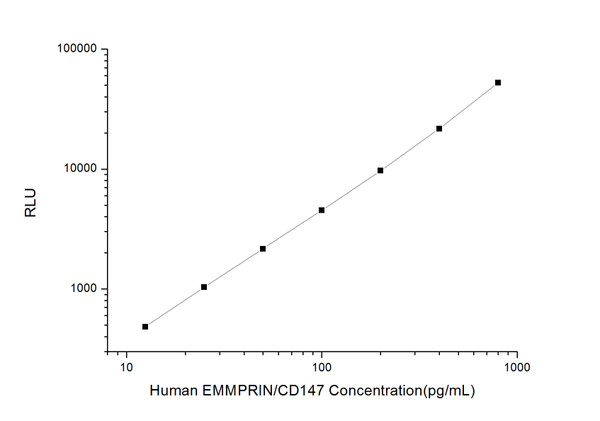| Tissue Specificity | Isoform 1: Retina-specific. Expressed in retinal cone photoreceptors (at protein level). Isoform 2: Expressed in erythrocytes (at protein level). Highly expressed in melanoma cell lines (at protein level). Highly expressed in the heart, kidney, skeletal muscle and testis. Isoform 3: Highly expressed in the bone marrow, fetal liver, lung, testis and thymus. Isoform 4: Highly expressed in the bone marrow, fetal liver, lung, testis and thymus. |
| Post Translational Modifications | Isoform 2: N-glycosylated. Isoform 3: N-glycosylated. Isoform 4: N-glycosylated. |
| Function | Isoform 1: Essential for normal retinal maturation and development. Acts as a retinal cell surface receptor for NXNL1 and plays an important role in NXNL1-mediated survival of retinal cone photoreceptors. In association with glucose transporter SLC16A1/GLUT1 and NXNL1, promotes retinal cone survival by enhancing aerobic glycolysis and accelerating the entry of glucose into photoreceptors. May act as a potent stimulator of IL6 secretion in multiple cell lines that include monocytes. Isoform 1: (Microbial infection) Erythrocyte receptor for P.falciparum RH5 which is essential for erythrocyte invasion by the merozoite stage of P.falciparum isolates 3D7 and Dd2. Isoform 2: Signaling receptor for cyclophilins, essential for PPIA/CYPA and PPIB/CYPB-dependent signaling related to chemotaxis and adhesion of immune cells. Plays an important role in targeting monocarboxylate transporters SLC16A1/GLUT1, SLC16A11 and SLC16A12 to the plasma membrane. Acts as a coreceptor for vascular endothelial growth factor receptor 2 (KDR/VEGFR2) in endothelial cells enhancing its VEGFA-mediated activation and downstream signaling. Promotes angiogenesis through EPAS1/HIF2A-mediated up-regulation of VEGFA (isoform VEGF-165 and VEGF-121) and KDR/VEGFR2 in endothelial cells. Plays a key role in regulating tumor growth, invasion, metastasis and neoangiogenesis by stimulating the production and release of extracellular matrix metalloproteinases and KDR/VEGFR2 by both tumor cells and stromal cells (fibroblasts and endothelial cells). Isoform 2: (Microbial infection) Erythrocyte receptor for P.falciparum RH5 which is essential for erythrocyte invasion by the merozoite stage of P.falciparum isolates 3D7, Dd2, 7G8 and HB3. Binding of P.falciparum RH5 results in BSG dimerization which triggers an increase in intracellular Ca(2+) in the erythrocyte. This essential step leads to a rearrangement of the erythrocyte cytoskeleton required for the merozoite invasion. Isoform 2: (Microbial infection) Can facilitate human SARS coronavirus (SARS-CoV-1) infection via its interaction with virus-associated PPIA/CYPA. Isoform 2: (Microbial infection) Can facilitate HIV-1 infection via its interaction with virus-associated PPIA/CYPA. Isoform 2: (Microbial infection) First described as a receptor for severe acute respiratory syndrome coronavirus 2 (SARS-CoV-2), it is not required for SARS-CoV-2 infection. Isoform 2: (Microbial infection) Acts as a receptor for measles virus. Isoform 2: (Microbial infection) Promotes entry of pentamer-expressing human cytomegalovirus (HCMV) into epithelial and endothelial cells. |
| Protein Name | Basigin5f7Collagenase Stimulatory FactorExtracellular Matrix Metalloproteinase InducerEmmprinHepatoma-Associated AntigenHab18gLeukocyte Activation Antigen M6Ok Blood Group AntigenTumor Cell-Derived Collagenase Stimulatory FactorTcsfCd Antigen Cd147 |
| Database Links | Reactome: R-HSA-1474228Reactome: R-HSA-210991Reactome: R-HSA-216083Reactome: R-HSA-433692Reactome: R-HSA-5619070Reactome: R-HSA-9749641 |
| Cellular Localisation | MelanosomeIdentified By Mass Spectrometry In Melanosome Fractions From Stage I To Stage IvIsoform 1: Cell MembraneSingle-Pass Type I Membrane ProteinPhotoreceptor Inner SegmentCell ProjectionCiliumPhotoreceptor Outer SegmentIsoform 2: Cell MembraneEndosomeEndoplasmic Reticulum MembraneBasolateral Cell MembraneIsoform 3: Cell MembraneIsoform 4: Cell Membrane |
| Alternative CLIA Names | Basigin CLIA kit5f7 CLIA kitCollagenase Stimulatory Factor CLIA kitExtracellular Matrix Metalloproteinase Inducer CLIA kitEmmprin CLIA kitHepatoma-Associated Antigen CLIA kitHab18g CLIA kitLeukocyte Activation Antigen M6 CLIA kitOk Blood Group Antigen CLIA kitTumor Cell-Derived Collagenase Stimulatory Factor CLIA kitTcsf CLIA kitCd Antigen Cd147 CLIA kitBSG CLIA kitUNQ6505 CLIA kitPRO21383 CLIA kit |
| Specificity | This kit recognizes Human EMMPRIN/CD147 in samples. No significant cross-reactivity or interference between Human EMMPRIN/CD147 and analogues was observed. |
| Reproducibility | Both intra-CV and inter-CV are |
Information sourced from Uniprot.org
| Item | Specifications | Storage |
| Micro CLIA Plate (Dismountable) | 96T: 8 wells ×12 strips strips | -20℃, 6 months |
| Reference Standard | 96T: 2 vials 48T: 1 vial | -20℃, 6 months |
| Concentrated Biotinylated Detection Ab (100×) | 96T: 1 vial, 120 μL 60 μL | -20℃, 6 months |
| Concentrated HRP Conjugate (100×) | 96T: 1 vial, 120 μL 60 μL | -20℃ (Protect from light), 6 months |
| Reference Standard & Sample Diluent | 1 vial, 20 mL | 2-8°C, 6 months |
| Biotinylated Detection Ab Diluent | 1 vial, 14 mL | 2-8°C, 6 months |
| HRP Conjugate Diluent | 1 vial, 14 mL | 2-8°C, 6 months |
| Concentrated Wash Buffer (25×) | 1 vial, 30 mL | 2-8°C, 6 months |
| Substrate Reagent A | 1 vial, 5 mL | 2-8℃ (Protect from light) |
| Substrate Reagent B | 1 vial, 5 mL | 2-8℃ (Protect from light) |
| Plate Sealer | 5 pieces | |
| Manual | 1 copy | |
| Certificate of Analysis | 1 copy | |
| Sample Type | Range (%) | Average Recovery (%) |
| Serum(n=8) | 92-103 | 98 |
| EDTA plasma(n=8) | 94-112 | 102 |
| Cell culture media(n=8) | 98-112 | 103 |
| | Intra-assay Precision | Intra-assay Precision | Intra-assay Precision | Inter-assay Precision | Inter-assay Precision | Inter-assay Precision |
| Sample | 1.00 | 2.00 | 3.00 | 1.00 | 2.00 | 3.00 |
| n | 20.00 | 20.00 | 20.00 | 20.00 | 20.00 | 20.00 |
| Mean (pg/mL) | 41.16 | 104.07 | 294.21 | 43.41 | 106.21 | 306.05 |
| Standard deviation | 4.73 | 8.94 | 26.98 | 5.53 | 7.54 | 21.85 |
| CV (%) | 11.49 | 8.59 | 9.17 | 12.74 | 7.10 | 7.14 |






